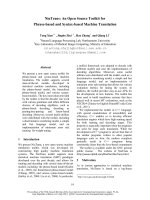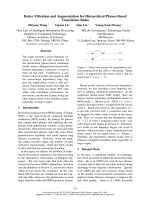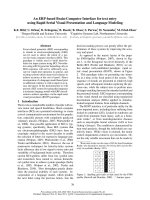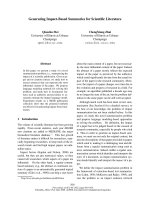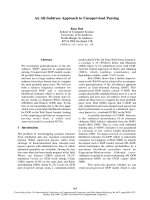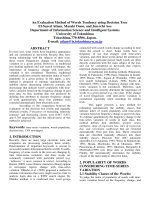Báo cáo khoa học: "An Ontology–Based Approach for Key Phrase Extraction" docx
Bạn đang xem bản rút gọn của tài liệu. Xem và tải ngay bản đầy đủ của tài liệu tại đây (135.06 KB, 4 trang )
Proceedings of the ACL-IJCNLP 2009 Conference Short Papers, pages 181–184,
Suntec, Singapore, 4 August 2009.
c
2009 ACL and AFNLP
An Ontology–Based Approach for Key Phrase Extraction
Chau Q. Nguyen
HCM University of Industry
12 Nguyen Van Bao St, Go Vap Dist,
HCMC, Vietnam
Tuoi T. Phan
HCMC University of Technology
268 Ly Thuong Kiet St, Dist 10,
HCMC, Vietnam
Abstract
Automatic key phrase extraction is funda-
mental to the success of many recent digital
library applications and semantic information
retrieval techniques and a difficult and essen-
tial problem in Vietnamese natural language
processing (NLP). In this work, we propose a
novel method for key phrase extracting of
Vietnamese text that exploits the Vietnamese
Wikipedia as an ontology and exploits spe-
cific characteristics of the Vietnamese lan-
guage for the key phrase selection stage. We
also explore NLP techniques that we propose
for the analysis of Vietnamese texts, focusing
on the advanced candidate phrases recogni-
tion phase as well as part-of-speech (POS)
tagging. Finally, we review the results of sev-
eral experiments that have examined the im-
pacts of strategies chosen for Vietnamese key
phrase extracting.
1 Introduction
Key phrases, which can be single keywords or
multiword key terms, are linguistic descriptors of
documents. They are often sufficiently informa-
tive to allow human readers get a feel for the es-
sential topics and main content included in the
source documents. Key phrases have also been
used as features in many text-related applications
such as text clustering, document similarity
analysis, and document summarization. Manu-
ally extracting key phrases from a number of
documents is quite expensive. Automatic key
phrase extraction is a maturing technology that
can serve as an efficient and practical alternative.
In this paper, we present an ontology-based ap-
proach to building a Vietnamese key phrase ex-
traction system for Vietnamese text. The rest of
the paper is organized as follows: Section 2
states the problem as well as describes its scope,
Section 3 introduces resources of information in
Wikipedia that are essential for our method, Sec-
tion 4 describes extraction of titles and its cate-
gories from Wikipedia to build a dictionary, Sec-
tion 5 proposes a methodology for the Vietnam-
ese key phrase extraction model, Section 6
evaluates our approach on many Vietnamese
query sentences with different styles of texts, and
finally the conclusion is presented in Section 7.
2 Background
The objective of our research is to build a system
that can extract key phrases in Vietnamese que-
ries in order to meet the demands associated with
information searching and information retriev-
ing, especially to support search engines and
automatic answer systems on the Internet. For
this purpose, we provide the following defini-
tion:
Key phrases in a sentence are phrases that
express meaning completely and also express the
purpose of the sentence to which they are as-
signed.
For an example, we have a query sentence as
follows:“Laptop Dell E1405 có giá bao nhiêu?”.
That means “How much does a Dell E1405 lap-
top cost? ”.
Key phrases are “Laptop Dell E1405”, “giá”, and
“bao nhiêu”. In this case, the interrogative word
“bao nhiêu” is used to add a meaning for the two
rest noun phrases, making the query of users
clear, wanting to know the numeral aspect about
the “price” of a “Laptop Dell E1405”.
3 Wikipedia
Wikipedia is a multilingual, web-based, freely
available encyclopedia, constructed as a collabo-
rative effort of voluntary contributors on the
web. Wikipedia grows rapidly, and with ap-
proximately 7.5 million articles in more than 253
languages, it has arguably become the world's
largest collection of freely available knowledge.
181
Wikipedia contains a rich body of lexical seman-
tic information, the aspects of which are compre-
hensively described in (Zesch et al., 2007). Addi-
tionally, the redirect system of Wikipedia articles
can be used as a dictionary for synonyms, spell-
ing variations and abbreviations.
A PAGE
.
A basic entry in Wikipedia is a page
that represents either a normal Wikipedia article,
a redirect to an article, or a disambiguation page.
Each page
object provides access to the article
text (with markup information or as plain text),
the assigned categories, the ingoing and outgoing
article links as well as all redirects that link to the
article.
A LINK. Each page consists of many links
which function not only to point from the page to
others, but also to guide readers to pages that
provide additional information about the entries
mentioned. Each link is associated with an an-
chor text that denotes an ambiguous name or is
an alternative name, instead of a canonical name.
CATEGORY. Category objects represent
Wikipedia categories and allow access to the ar-
ticles within each category. As categories in
Wikipedia form a thesaurus, a category object
also provides means to retrieve parent and child
categories as well as siblings and all recursively
collected descendants.
REDIRECT PAGE. A redirect page typically
contains only a reference to an entry or a concept
page. The title of the redirect page is an alterna-
tive name for that entity or concept.
DISAMBIGUATION PAGE. A disambiguation
page is created for an ambiguous name that de-
notes two or more entities in Wikipedia. It con-
sists of links to pages that define different enti-
ties with the same name.
4 Building a dictionary
Based on the aforementioned resources of infor-
mation, we follow the method presented in
(Bunescu and Pasca, 2006) to build a dictionary
called ViDic. Since our research focuses on Key
phrases, we first consider which pages in
Wikipedia define concepts or objects to which
key phrases refer. The key phrases are extracted
from the title of the page. We consider a page
has key phrases if it satisfies one of the following
steps:
1. If its title is a word or a phrase then the title
is key phrase.
2. If its title is a sentence then we follow the
method presented in (Chau and Tuoi, 2007)
to extract key phrases of the sentence.
Following this method, the ViDic is constructed
so that the set of entries in the ViDic consists of
all strings that denote a concept. In particular, if
c is a concept, its key phrases, its title name, its
redirect name and its category are all added as
entries in the ViDic. Then each entry string in the
ViDic is mapped to a set of entries that the string
may denote in Wikipedia. As a result, a concept
c is included in the set if, and only if, the string
has key phrases which is extracted from the title
name, redirect name, or disambiguation name of
c.
Although we utilize information from Wikipedia
to build the ViDic, our method can be adapted
for an ontology or knowledge base in general.
5 Proposed method
We consider the employment of a set of NLP
techniques adequate for dealing with the Viet-
namese key phrase extraction problem. We pro-
pose the following general Vietnamese key
phrase extraction model (see Figure 1).
5.1 Pre-processing
The input of pre-processing is user’s queries and
the output is a list of words and their POS labels.
Because of the effectiveness and convenience
associated with integrating two stages of word
segmentation and POS tagging, we proposed two
modules for the pre-processing stage. The pur-
poses of two modules are as follows:
• Word Segmentation: The main function of
this segmentation module is to identify and
separate the tokens present in the text in such a
way that every individual word, as well as
every punctuation mark, will be a different to-
ken. The segmentation module considers
words, numbers with decimals or dates in nu-
Figure 1. The general Vietnamese key phrase
extraction model.
Key
phrases
Patterns
Ontology
ViO &ViDic
Key phrases
extraction
Candidate phrases
identif
i
cation
Vietnamese texts
Pre-processing
POS Ta
g
ging
Segment
a
tion
182
merical format in order not to separate the dot,
the comma or the slash (respectively) from the
preceding and/or following elements.
• POS tagging: The output of the segmentation
module is taken as input by the POS tagging
module. Almost any kind of POS tagging
could be applied. In our system, we have pro-
posed a hybrid model for the problem of Viet-
namese POS Tagging (Chau and Tuoi, 2006).
This model combines a rule-based method and
a statistical learning method. With regard to
data, we use a lexicon with information about
possible POS tags for each word, a manually
labeled corpus, syntax and context of texts.
5.2 Candidate phrases identification
The input of the candidate phrase identification
is a list of words and their POS labels, and the
output is a list of words and their chunking la-
bels. The idea underlying this method (Chau and
Tuoi, 2007) for the Vietnamese key phrase ex-
traction is based on a number of grammatical
constructions in Vietnamese. The method con-
sists of pattern-action rules executed by the fi-
nite-state transduction mechanism. It recognizes
entities such as noun phrases. In order to accom-
plish the noun phrases recognition, we have de-
veloped over 434 patterns of noun phrase groups
that cover proper noun constructs.
5.3 Key phrases extraction
In this section, we focus on the description of a
methodology for key phrase extraction. This
method combines a pattern-based method and a
statistical learning method. Both methods will
complement each other to increase the expected
performance of the model. In particular, the
method has the following steps:
• Step 1: We propose a method that exploits
specific characteristics of Vietnamese (Chau and
Tuoi, 2007). At the heart of this method is the
idea of building a Vietnamese words set that re-
flects semantic relationships among objects. For
example, consider the sentence that follows:
“Máy tính này có dung lng RAM ln nht là
bao nhiêu ?” that means “What is the largest
RAM capacity for this computer?”
In this sentence, we have two objects “Máy
tính”(this computer) and “RAM” in real world.
Respectively, two noun phrases are “Máy
tính”(this computer) and “dung lng RAM ln
nht” (the largest RAM capacity). We consider
the meanings of words per the above example;
we will recognize “có”, a meaning word in our
meaning word set, which reflects a possessive
relationship between “Máy tính” and “dung
lng RAM ln nht”. This has identified “dung
lng RAM ln nht” representing the meaning
of the sentence.
This meaning word-based approach provides a
set of semantic relationships (meaning words)
between phrases to support key phrase extrac-
tion, which does not require building a hierarchy
or semantic networkof objects in the Vietnamese
language.
• Step 2: In case the sentence has no meaning
word among phrases, the key phrase extracting
process is based on the ViO ontology via concept
matching. In particular, this step has the follow-
ing phases:
1. every candidate phrase in the sentence is
matched to an entry in the VicDic dictionary
especially when new phrases are not a con-
cern or do not exist in the dictionary. Be-
cause a partial matching dilemma usually ex-
ists, we apply several strategies to improve
the matching process, including maximum
matching, minimum-matching, forward-
matching, backward-matching and bi-
directional matching.
2. if the matching process is successful, then
we retrieve categories for the entries respec-
tively via the category system in the ViO on-
tology; if the candidate phrase has the most
specific category, then the phrase is the key
phrase of the sentence indicated in Step 3.
3. if the matching process is not successful,
then we find a semantic similarity concept in
the ViO ontology as Step 4. After that, the
key phrase extracting process will go to
phase 2.
• Step 3: The idea of the most specific category
identification process based on the ViO ontology
is shown as pseudo-code, such as
Algorithm: the most specific category identification
- Input: C
1
, C
2
categories, and the ViO Ontology
- Output: C
1
or C
2
or both C
1
and C
2
1. begin
2. if C
1
& C
2
have a synonyms relationship in ViO
3. then C
1
& C
2
are the most specific categories
4. else if C
1
has isa relationship of C
2
then C
1
is the
most specific category.
5. to traverse the ViO ontology from C
1
& C
2
to
find the nearest common ancestor node (C’).
Calculate the distance between C
1
and C’ (h
1
),
distance C
2
and C’ (h
2
).
6. if h
1
> h
2
then C
1
is the most specific category
7. else if h
1
< h
2
then C
2
is the most specific
183
category
8. else C
1
& C
2
are the most specific categories
9.
end;
• Step 4: To find the semantic similarity concept
for each concept t that is still unknown after
phase 2, we traverse the ontology hierarchy from
its root to find the best node. We choose the se-
mantic similarity that was described as in
(Banerjee and Pederson, 2003). However, we do
not use the whole formula. In particular , we use
a similar formula that is specified as follows:
Acu_Sim(w, c) = Sim(w, c) + Sim(w, c’)
in which, w is the phrase that needs to be anno-
tated, c is the candidate concept and c’ is the
concept that is related to c.
At the current node c while traversing, the simi-
larity values between t and all children of c are
calculated. If the maximum of similarity values
is less than similarity value between t and c, then
c is the best node corresponding to t. Otherwise,
continue the procedure with the current node as
the child node with the maximum similarity
value. The procedure stops when the best node is
found or it reaches a leaf node.
6 Evaluation
To evaluate the result of the proposed model, we
use recall and precision measures that are de-
fined as in (Chau & Tuoi, 2007). In order to test
the model we selected a questions set from
sources on the web as follows:
• TREC (Text REtrieval Conference)
( TREC-07 (con-
sisting of 446 questions); TREC-06 (consist-
ing of 492 questions); and TREC-02 (con-
sisting of 440 questions).
• The web page www.lexxe.com: consisting of
701 questions.
After that, the question set (consisting of 2079
questions) is translated into a Vietnamese ques-
tions set, we called D
1
dataset. All key phrases of
the D
1
dataset are manually extracted by two lin-
guists for the quality of the dataset. Then we
have two versions respectively, V
1
and V
2
. The
results of our system is shown as follows:
Ver R A Ra Precision Recall
V
1
3236 3072 2293 74.6% 70.8%
V
2
3236 3301 2899
89.6% 87.8%
Table 1. Results of Vietnamese key phrase extraction.
7 Conclusion
We have proposed an original approach to key
phrase extraction. It is a hybrid and incremental
process for information searching for search en-
gines and automatic answer systems in Vietnam-
ese. We achieved precision of around 89.6% for
our system. The experimental results have show
that our method achieves high accuracy.
Currently, Wikipedia editions are available for
approximately 253 languages, which means that
our method can be used to build key phrase sys-
tems for a large number of languages. In spite of
the exploitation of Wikipedia as a Vietnamese
ontology, our method can be adapted for any on-
tology and knowledge base in general.
Furthermore, we had to construct all necessary
linguistic resources and define all data structures
from scratch, while enjoying some advantages
derived from the many existent methodologies
for morpho-syntactic annotation and the high
consciousness of a standardization tendency.
Specifically, we built a set with 434 noun phrase
patterns and a rules set for Vietnamese key
phrase identification. Our patterns and rules set
can be easily readjusted and extended. The re-
sults obtained lay the foundation for further re-
search in NLP for Vietnamese including text
summarization, information retrieval, informa-
tion extraction, etc.
References
Bunescu, R., Pasca, M. 2006. Using encyclopedic
knowledge for name entity disambiguation. In Pro-
ceedings of the 11th Conference of EACL:9-16.
Banerjee S.,Pederson T., 2003. Extended Gloss Over-
laps as a Measure of Semantic Relatedness, In Pro-
ceedings of the 18th International Joint Conference
on Artificial Intelligence (IJCAI-03): 805–810.
Chau Q.Nguyen, Tuoi T.Phan. 2007. A Pattern-based
Approach to Vietnamese Key Phrase Extraction, In
Addendum Contributions of the 5
th
International
IEEE Conference on Computer Sciences- RIVF’07:
41-46.
Chau Q.Nguyen, Tuoi T.Phan. 2006. A Hybrid Ap-
proach to Vietnamese Part-Of-Speech Tagging. In
Proceedings of the 9th International Oriental CO-
COSDA Conference (O-COCOSDA’06), Malay-
sia:157-160.
Zesch, T., Gurevych, I. 2007. Analysis of the Wikipe-
dia Category Graph for NLP Applications. In Pro-
ceedings of the TextGraphs-2 Workshop (NAACL-
HLT 2007):1–8.
184


